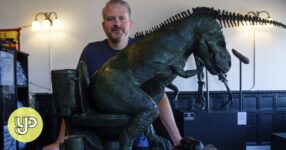
What poo can teach scientists about dinosaurs and other ancient animals – YP
Have you ever had questions about the eating habits of the Tyrannosaurus rex? One way to learn more is to look at its poop.
Bone fragments in a piece of fossilised excrement at a museum in the US state of Arizona – aptly called the Poozeum – indicate that the T. rex wasn’t much of a chewer, preferring to swallow whole chunks of prey.
The Poozeum, with its more than 7,000 coprolite specimens on display, is a testament to the importance of these fossilised faeces in understanding our prehistoric past. The museum opened in May in the town of Williams. The town is known for its Wild West shows along the historic Route 66, wildlife attractions and a railway to Grand Canyon National Park. It plays a crucial role in educating the public about coprolites and their role in palaeontology.
Inside, display cases filled with coprolites – fossilised faeces from animals that lived millions of years ago – line the walls. They range from minuscule termite droppings to a massive specimen that weighs 9kg.
The president and curator of the Poozeum, George Frandsen, is a renowned expert in the field. He said he bought his first chunk of fossilised faeces from a shop in Moab, in the nearby state of Utah, when he was 18. He already loved dinosaurs and fossils but had never heard of fossilised poop.
“It was funny. It was gross,” he said. “But I learned very quickly it could tell us so much about our prehistoric past and how important they are to the fossil record.”
Executive director of the New Mexico Museum of Natural History and Science Anthony Fiorillo said coprolites aren’t tremendously common. Still, they can make up most fossils found at some sites, and people have learned more about them over the past few decades.
Palaeontologist explains his role in showing feathered dinosaurs to the world
Identifying coprolites can be challenging. In some cases, specimens that appeared to be coprolites – with their pinched ends and grooves – were examined further and ultimately reclassified as something else. This process involves careful observation, comparison with known specimens and sometimes even chemical analysis.
Frandsen said there is no need to worry about smells or germs. Those evaporated millions of years ago when the faeces were covered with sediment and replaced by minerals, making them rock-hard. Fiorillo said the location, shape, size, and other materials, such as bones or plants, can determine if something is a coprolite. However, this information can’t always reveal which creature deposited it.
“I think most of us would say, ‘let’s pump the brakes on that’ and just be happy if we could determine [if it was a] carnivore or herbivore and then look at the food cycles within each of those broad groups,” said Fiorillo, a trained palaeontologist and author of books on dinosaurs.
A highlight of Frandsen’s collection is a specimen with a Guinness World Record for being the largest coprolite left by a carnivorous animal. Measuring more than 61cm long and over 15cm wide, Frandsen said it is believed to be from a T. rex, given where it was found on a private ranch in South Dakota in 2019.
Associated Press
What can we learn from coprolites?
There are two main groups of fossils: body fossils and trace fossils. Coprolites are trace fossils, meaning they are not part of the animal’s body.
They are the fossilised faeces of animals that lived millions of years ago. Fossilisation occurs when the faeces are buried in sediment, preventing decay and allowing the organic material to be replaced by minerals over time.
Scientists can learn more about an animal’s diet by studying the shape and size of coprolites and where they were found. However, it is hard to know exactly what animal made a coprolite because the animal’s body is usually not found in the same spot.
A spiral-shaped coprolite might have come from an ancient shark or another kind of fish. This is because some modern fish have spiral-shaped intestines.
Coprolites can also tell scientists what the animal that made them ate. If they find pieces of bones, it means the animal was a meat-eater. If the scientists find seeds, leaves, pollen or bark in the coprolite, it shows that the animal was a plant-eater.



